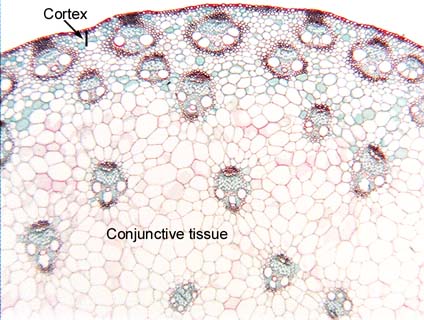 Fig.
11.1-2. Transverse section of corn stem (Zea mays).
This is the organization you will see in stems of monocots: numerous vascular
bundles distributed throughout a wide tissue that may be either parenchyma or
fibers. It has the following four parts:
Fig.
11.1-2. Transverse section of corn stem (Zea mays).
This is the organization you will see in stems of monocots: numerous vascular
bundles distributed throughout a wide tissue that may be either parenchyma or
fibers. It has the following four parts:
1) epidermis
2) cortex (with or without part of it being differentiated into a hypodermis)
3) vascular bundles
4) a matrix called conjunctive tissue.
Many people use the word “pith” instead of conjunctive tissue for monocots, but in fact we are not entirely certain what this evolved from (see pages 206 to 214 in Plant Anatomy (Mauseth)). Monocot stems, in which the stele consists of many vascular bundles in a complex arrangement, are said to have an atactostele. Often, people will describe the vascular bundles of monocot stems as “scattered,” but that implies they are random, and have no pattern. If you could see the bundles in three dimensions, examining a length of stem, you would see that they have an extremely precise arrangement, it is just too complex to understand it by examining a transverse section.